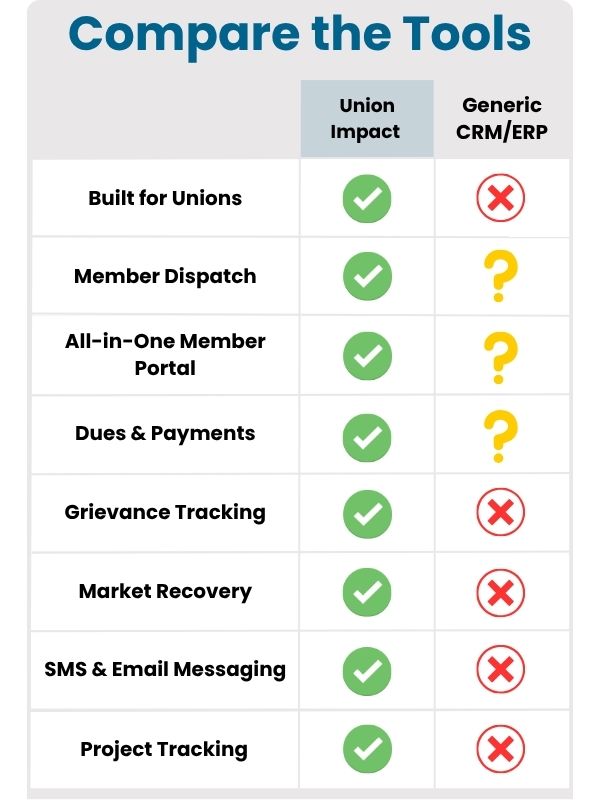Union Data Migration Risks & How to Avoid Them
Why secure migration matters for union data integrity
When unions modernize their systems, data migration is often the most stressful step. Member databases hold decades of records—dues payments, dispatch history, grievances, certifications—and a single mistake can cause lost trust, compliance problems, or even legal issues.
This blog explores the top risks of union data migration and shows how a structured, done-for-you process prevents errors.

Risk 1: Data Loss During Migration
Why It Happens
Old systems often use outdated formats or inconsistent structures.
Spreadsheets may contain duplicate or incomplete records.
Without validation, essential information can be dropped during transfer.
How to Prevent It
Conduct pre-migration audits to identify gaps.
Use mapping tools to align old fields with new system fields.
Run test migrations to validate results before going live.
For more on structured migrations, see Union Database Migration & Management.
Risk 2: Inaccurate or Corrupted Records
Why It Happens
Legacy databases often store data inconsistently (e.g., date formats, name spellings).
Manual imports can introduce errors.
Files may include corrupted or outdated entries.
How to Prevent It
Standardize data formats before migration.
Run integrity checks to flag anomalies.
Use reconciliation reports to compare pre- and post-migration totals (e.g., member counts, dues balances).

Our platform is hosted only in SOC 2 Type II / SOC 3 Type II–audited data centers, giving you a proven compliance baseline from day one.
Nightly Off-Site Backups
Your data is backed up automatically every night to a separate, secure data center—so you’re protected from accidental loss or hardware failures.
Security You Can Trust
Your connection to our system is encrypted with HTTPS (SSL/TLS) using 2048-bit certificates, ensuring your data stays private and tamper-resistant in transit.
Risk 3: Security Breaches or Exposure
Why It Happens
Sensitive union data (member addresses, SSNs, payment info) may be exposed during transfer if not encrypted.
Using insecure file transfer methods (email attachments, USB drives) creates vulnerability.
Lack of role-based access can allow unauthorized staff to view private data.
How to Prevent It
Encrypt data during transfer and at rest.
Use secure, audited environments for migration.
Apply role-based access so only authorized staff handle sensitive files.
For additional cybersecurity protections, unions can consult Business Computer Technicians.

Dedicated Infrastructure: Your security is our priority. Every client receives their own dedicated server, meaning your data is never co-mingled with anyone else’s. This private environment ensures maximum security and performance.
Choose a reliable partner that follows the latest security protocols.
Risk 4: Compliance Failures
Why It Happens
Incomplete records during migration may affect LM-2/LM-3 filings.
Lost grievance data can undermine arbitration or legal cases.
Missing dispatch logs can create disputes about referral fairness.
How to Prevent It
Ensure migration includes time-stamped logs and historical records, not just current data.
Validate compliance-related fields like dues, grievance timelines, and dispatch history.
Create export-ready compliance reports immediately after migration to confirm readiness.
For insights on reporting, see Custom Union Report Management.

Data Sovereignty Guaranteed: We are a U.S.-based company and store all American client data on servers within the United States.

To meet Canadian privacy laws: all Canadian client data is hosted exclusively in Canadian data centers.

For nearly two decades, we’ve been a trusted partner to union halls across North America.
Since 2006, our hands-on experience has given us a deep understanding of the unique challenges you face. We are proud to provide powerful, tailored solutions that solve those challenges and make a real impact on your operations.
Risk 5: Poor Adoption After Migration
Why It Happens
If data is disorganized, staff may not trust the new system.
Members may complain if their records are missing or wrong.
Lack of training leaves officers unsure how to use the software.
How to Prevent It
Provide role-based training for staff and officers.
Validate member-facing fields so profiles display correctly.
Track KPIs like dispatch speed and dues collection rates after migration to confirm improvements.
When handled properly, data migration is not a liability but a launchpad. By addressing these risks up front, unions can modernize confidently and take full advantage of secure, integrated software.

Union Impact was founded on one principle: unions deserve software designed for them—not retrofitted business tools. By handling migration, integrating core modules, and focusing on compliance and transparency, Union Impact gives locals the tools to stay organized, retain members, and grow.
To hear directly from locals using our platform, see Union Client Testimonials.






